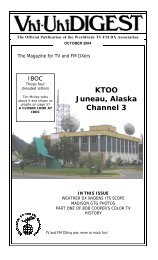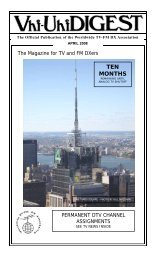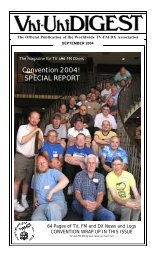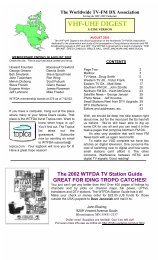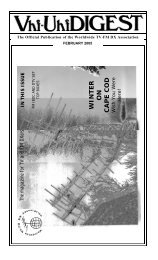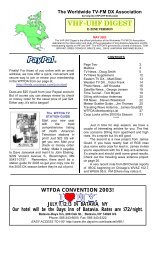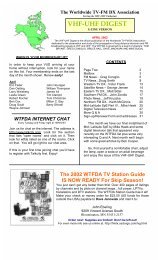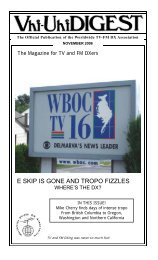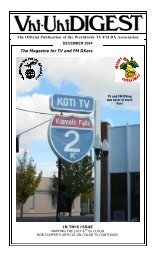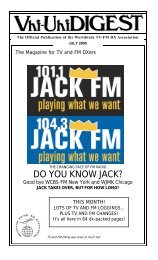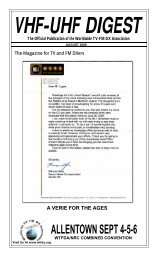How To Improve YOUR UHF Reception! - This is WTFDA.org
How To Improve YOUR UHF Reception! - This is WTFDA.org
How To Improve YOUR UHF Reception! - This is WTFDA.org
Create successful ePaper yourself
Turn your PDF publications into a flip-book with our unique Google optimized e-Paper software.
<strong>How</strong> <strong>To</strong> <strong>Improve</strong><strong>YOUR</strong> <strong>UHF</strong> <strong>Reception</strong>!The results of th<strong>is</strong> FCC study can help you improve your <strong>UHF</strong>-TV reception significantly. <strong>Th<strong>is</strong></strong> article <strong>is</strong> based on theJuly 1981 Radio Electronics article by Denn<strong>is</strong> C Brown.Did you ever w<strong>is</strong>h you could test dozens of tv-receptionaccessories (like antennas, preamps, lead-ins, splitters, connectors and baluns) beforedeciding which to buy to improve your reception? The Federal Communications Comm<strong>is</strong>sionhas done it for you. In th<strong>is</strong> report, we will reveal which <strong>UHF</strong>-TV antenna-system componentswere found to be the best when tested for the FCC by the electronics labs of The Ge<strong>org</strong>iaInstitute of Technology.Three caveats are in order: First, although no doubt every effort was made to bethorough in the selection of components to test, some manufacturers’ products may not havebeen tested. Om<strong>is</strong>sion of some product from the report should not be taken to indicate anyconclusion about that product. Second, the Ge<strong>org</strong>ia Tech study does not take into accountvariations from unit to unit and from batch to batch in a maker’s line for the more expensiveproduct. Thus, the unit tested may have been a lemon, an exceptionally good piece, or anaverage sample. Third, because the public release was expected to be confidential in regardto the manufacturers’ names, the report’s conclusions should not be taken as either critic<strong>is</strong>mor endorsement of a particular product or manufacturer by either Ge<strong>org</strong>ia Tech or the FCC.Before we look at the test results themselves, let’s look at Ge<strong>org</strong>ia Tech’s generalconclusions: 1. <strong>UHF</strong>-only antennas provide better <strong>UHF</strong> performance than <strong>UHF</strong>-VHFcombination antennas providing, on the average, a 2db gain advantage. 2. Considering bothoverall performance and cost, the outdoor 4-bay bowtie antenna, at an approximate cost of$10, <strong>is</strong> considered the best antenna choice for <strong>UHF</strong> reception for most installations. 3. Thereare significant differences among preamps, with gains varying from –16db (an actual loss) to+35db, and with no<strong>is</strong>e figures varying from 2.5db to 12db. 4. The benefit of a preamp <strong>is</strong> that itlowers the system no<strong>is</strong>e figure, with a no<strong>is</strong>e figure between 3db and 5db desirable. 5. Apreamp mounted at the antenna will give better performance than one mounted indoors at thereceiver. The improvement in performance <strong>is</strong> approximately equal to the loss suffered in thetransm<strong>is</strong>sion line. A preamp gain of about 20db <strong>is</strong> desirable. A gain of 15db may be adequate,while more than 20db may be too much except in fringe areas. 7. Coaxial cables have thelowest VSWR and shielded twin-lead shows the highest VSWR. 8. RG-6/U coax <strong>is</strong> the bestchoice for <strong>UHF</strong>-TV reception. 9. There <strong>is</strong> no clear correlation between the price of a splitterand its performance character<strong>is</strong>tics. 10. Insertion loss of splitters tested ranged from .1db to5db and insertion-loss differences among samples of the same model varied from .3 to 2.2db11. Splitter VSWR values ranged from 1.05:1 (very good) to 6.4:1 (not so good). 12. Theredoes not appear to be much correlation between the price of a balun and its actualperformance. 13. Insertion loss of the four models of baluns from three manufacturers rangedfrom .3db to 2.7db with insertion loss difference among samples of the same model varyingfrom .2 to .9db. The receiving system that the engineers considered to represent the optimumcomprom<strong>is</strong>e between price and performance costs approximately $70 and cons<strong>is</strong>ts of a <strong>UHF</strong>only4 bay bowtie outdoor antenna, a <strong>UHF</strong>-only preamp with a no<strong>is</strong>e figure of 2db to 5db anda gain of 20db, and RG-6/U transm<strong>is</strong>sion line.Antennas. As could be expected from an understanding of antenna theory, theChannel Master 6 foot parabolic d<strong>is</strong>h antenna showed the highest gain and narrowestbeamwidth but an unexpectedly low front-to-back ratio possibly because ribs, rather thanscreen wire are used for the reflector.Preamplifiers. No one preamp tested showed all the character<strong>is</strong>tics that one mightdesire, but Ge<strong>org</strong>ia Tech concluded that the Winegard model AC-4990 was probably the bestamplifier tested.Transm<strong>is</strong>sion Lines. All things considered, the additional cost of good coax in a Uhfsystem <strong>is</strong> truly trivial and coax should be your choice for transm<strong>is</strong>sion line.Splitters. Ge<strong>org</strong>ia Tech found no clear correlation between the cost and performanceof the splitters tested. Ge<strong>org</strong>ia Tech concluded that installing two transm<strong>is</strong>sion lines (one forVHF and one for <strong>UHF</strong>) to eliminate use of a splitter <strong>is</strong> a reasonable alternative. An additional
50 feet of RG-6/U cable will probably cost only a dollar or two more than a splitter, but willgive better results.Baluns. Ge<strong>org</strong>ia Tech tested several samples of four balun models. They found thatthere was little correlation between price and performance. Insertion loss variation amongsamples of the same model ranged from .2 to .9db.Connectors. Ge<strong>org</strong>ia Tech engineers observed that type of connectors used and thenature of the connection itself can have a significant effect on performance. In fact, their effecton picture quality sometimes seems to be magic. What appears to be a perfectly goodconnection may give a m<strong>is</strong>erable picture while a shaky connection that you w<strong>is</strong>h you couldtrust to stay together givs a superb image on the screen. Engineers noted that twin-lead plugsand sockets, spade lugs and terminal strips all d<strong>is</strong>played such high VSWR levels that theycould not be used in the test program. Engineers concluded that F-type connectors“accompl<strong>is</strong>h good coaxial connections if the connectors are properly installed and noproblems should be encountered when frequent d<strong>is</strong>connections and connections are notrequired. “<strong>UHF</strong> Outdoor Antenna Performance Character<strong>is</strong>ticsModel Type Max Gain Min Gain Beamwidth F/b ratioCM 4228A 8 Bay Bowtie 15 9.5 21.1 17.9Winegard KU420 4 Bay Bowtie 13.1 9.0 49.4 14.5Radio Shack U-100 C/R Yagi 13.5 -6.8 37.8 11.0Winegard CH-9075 C/R Yagi 13.5 -3.0 38.5 8.1Finco P-5 5’ parabolic 13.9 -1.1 21.6 10.3CM-4250 6’ parabolic 17.9 11.7 16.1 11.0Summary of <strong>UHF</strong> PreampsModel Type Impedance Gain Max Gain Min No<strong>is</strong>eR. Shack 15-1134 U/V 300/75 16.3 4.9 5.1R.Shack 15-1134 U/V 300/300 18.1 7.5 5.2Winegard AC-4990 <strong>UHF</strong> 300/75 20.0 11.1 4.6Summary of <strong>UHF</strong>/VHF Combination AntennasModel Type Max Gain Min Gain Beamwidth F/B RatioCM 4795 VHF-LP <strong>UHF</strong> C/R Yagi 6.0 -5.0 37.4 10.2R.Shack VU-110 VHF-LP V <strong>UHF</strong>C/R Yagi 10.5 0.0 31.3 7.1R.Shack VU-160 “ “ 12.0 2.5 34.9 8.5Winegard CH-7080 VHF LP, <strong>UHF</strong> Yagi 10.1 4.0 44.2 14.1



